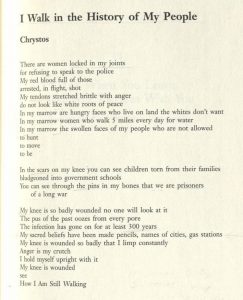In Chrystos’s “I Walk in the History of My People,” printed in all four editions of This Bridge Called My Back beginning in 1981, the speaker also embodies the history of her ancestors and the heritage they have passed on to her. Her physical body holds the pain of “my people” who are “prisoners / of a long war” (4th ed., lines 9, 15-16). Though her “joints,” “blood,” “tendons,” “marrow,” and “knee” sting with the pain of these people, she continues to walk, to resist, and to know “How I Am Still Walking” (1, 3, 5, 7, 17, 26).

“I Walk in the History of My People,” as printed in the fourth edition of This Bridge Called My Back.
Specific images of human suffering dwell within the parts of her body. Her “red blood” is “full of those / arrested, in flight, shot” and in her marrow live the “hungry faces who live on land the whites don’t want” (3-4, 7). Women in particular suffer and cause her suffering: women who are “refusing to speak to the police” and “women who walk 5 miles every day for water” (2, 8). Anger too, subsists in her physical body, as she confesses that “my tendons stretched brittle with anger / do not look like white roots of peace” (5-6). Her tendons, the roots that connect her muscles and tissue, cannot blossom into fruitful “roots of peace” (6). Although her anger prevents her from finding or creating peace, she indicates that “anger is my crutch” which allows her to “hold myself upright” and continue to walk (22, 23). Her anger both pains and supports her.
The interpretations of history in “I Walk in the History of My People” and “I am Brown” diverge. In “I am Brown,” the speaker derives a mystical power from the history of her ancestors, while the speaker in “I Walk in the History of My People” likens the past to an “infection” that “has gone on for at least 300 years” and “oozes from every pore” (18, 19). The speaker lives in spite of, not in union with, this history of pain and violence. She refers to colonialism, at the root of this infection, which has existed in the Americas since the seventeenth century, approximately 300 years before the publication of this poem in This Bridge Called My Back.
In four editions published between 1981 and 2015, This Bridge Called My Back has honored the struggles of women like the speaker in “I Walk in the History of My People” for decades. This anthology of “writings by radical women of color” honors these experiences and calls for women of color to resist their oppressors and march on, just like the speaker in this poem.
Sources:
Anzaldúa, Gloria, and Moraga, Cherríe, editors. This Bridge Called My Back: Writings by Radical Women of Color. 4th ed., State University of New York Press, 2015.
Chrystos. “I Walk in the History of My People.” Anzaldúa, Gloria, and Moraga, Cherríe, editors. This Bridge Called My Back: Writings by Radical Women of Color. 4th ed., State University of New York Press, 2015.
